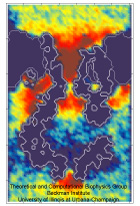Highlights of our Work
2024 | 2023 | 2022 | 2021 | 2020 | 2019 | 2018 | 2017 | 2016 | 2015 | 2014 | 2013 | 2012 | 2011 | 2010 | 2009 | 2008 | 2007 | 2006 | 2005 | 2004 | 2003 | 2002 | 2001
Bacterial cells, like those of Escherichia coli, protect
themselves against sudden inside-out pressure differences that
arise osmotically from changes in a cell's environment and
that could burst the cellular envelop. The protection is achieved
through so-called mechanosensitive channels in the cell membrane. One
such channel, that dissipates like a safety valve pressure
differences across the Escherichia coli cell membrane, is
contributed by the protein MscS. Upon tension in the cell
membrane, that can also be applied systematically in the
laboratory, the channel opens and permits molecules to pass, as
best measured through an ion current leaking through the
stretched membrane. MscS is a channel with a balloon-like
filter, the function of the latter being still a mystery (see
Nov 2004 highlight, "Japanese lantern protein"). Now
computational biologists using NAMD teamed up with
device engineers using BioMoca to study MscS as
reported recently. The team monitored the
mysterious MscS computationally over several
microseconds, a record time for protein simulations. MscS was
found to permit water passage, but to
also exhibit strong electrostatic forces that focus ions
streaming through its filter balloon and channel. This suggests
MscS to be both a hydrostatic and an electrical safety valve.
Even though now better known, MscS' entire function remains
shrouded in mystery (more on our MscS web site).




